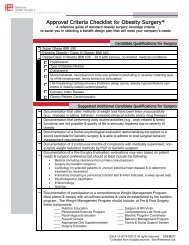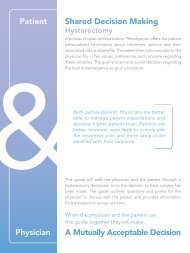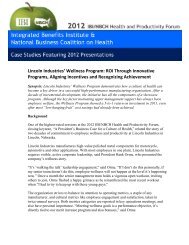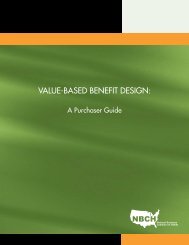Obesity/Weight Management Employer Survey and Interview Project
Obesity/Weight Management Employer Survey and Interview Project
Obesity/Weight Management Employer Survey and Interview Project
- No tags were found...
You also want an ePaper? Increase the reach of your titles
YUMPU automatically turns print PDFs into web optimized ePapers that Google loves.
plans <strong>and</strong> vendors or consultants. These employersmay need to have access to unbiased information fromother organizations to complement what they receivethrough their plan, vendor, or consultant relationships.<strong>Employer</strong>s note that some of the information may comefrom CDC <strong>and</strong> other credible resources; however, thereis still a need to look at the sources vendors <strong>and</strong> plansuse to inform their employer customers.<strong>Employer</strong>s use the information that they seek out fora number of purposes. The most common use of theinformation obtained is to:E Educate employees (84.2% of respondents),E Reference (70.4%),E Provide data to others (65.0%),E Improve or design programs (57.9%), <strong>and</strong>E Educate decision makers (43.3%).Given the number of employers without a workplaceobesity program, references <strong>and</strong> educational resourcesfor decision makers are essential. However, allemployers would benefit from tools <strong>and</strong> information tobetter engage employees.Only a little more than a third of employers (36.7%)reported that they use the information from externalorganizations for decision-making or setting policy.This indicates that either employers prefer to baseorganizational decisions on internal data or that thedata <strong>and</strong> information provided by these organizations isnot sufficiently relevant to be usable.E Very small employers (43%) are the least likelyto use the information they seek out to design orimprove their programsE Very small employers (33%) are also the least likelyto use the information they obtain for the purposesof making decisions or setting policy. Both of thesefindings indicate that the information currentlyavailable does not adequately address the needs ofworksites with fewer than 100 employees.Product Utility to <strong>Employer</strong>s. Respondents were askedabout the types of products they would find to be mosthelpful to initiate workplace obesity prevention <strong>and</strong>control program or support their ongoing activities.Overall, web tools were viewed as the most useful,with an average score of 3.66 out of 5. Other usefultools included checklists (average score of 3.38),intervention templates or models (average score of3.37), a business case (average score of 3.34), <strong>and</strong>certificates, certification or recognition (average score of3.33). The least useful products for employers were casestudies (average score of 3.12) <strong>and</strong> publications in trade,professional, or scientific journals (average score of 3.13)The web tools query did not distinguish between webtools for employees versus those for the employer.<strong>Interview</strong>s reinforced the need for, not only web tools<strong>and</strong> information, but also for other forms of accessto <strong>and</strong> delivery of information. <strong>Employer</strong>s need thisinformation since many employees do not have accessFigure 13: Percent of <strong>Employer</strong>s Reporting Productsare “Useful <strong>and</strong> Very Useful” by <strong>Employer</strong> SizeVery SmallSmallMid-SizeLargeVery Large80%70%60%50%40%30%20%10%0%Web tools Checklists InterventionTemplate/ModelBusinessCaseCertificate,Certification,RecognitionResourceList/Inventory18National Business Coalition on Health









